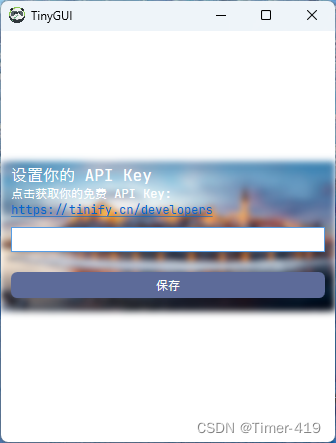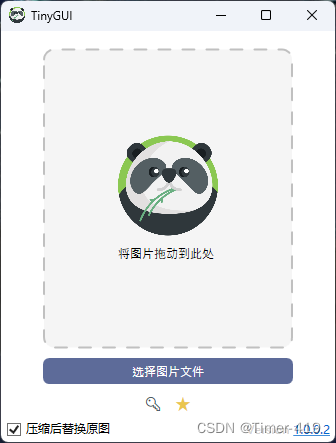-
使用TinyPNG API压缩图片
使用TinyPNG API压缩图片
在撰写论文的时候,美观,大气,上档次的图标能够很好地给自己的论文加分,好的可视化结果也能够让审稿人赏心悦目。但是有时候在可视化图片的时候有可能原始图像过大从而很占内存;这时候就希望能够是有一个无损压缩工具来压缩图像。目前笔者尝试过TinyPNG 感觉能够达到较好的压缩效果而且基本上不影响视觉效果。而且也有对应的安装包TinyGUI, TinyGUI 是网友根据TinyPNG提供的应用程序接口开发的本地桌面端工具。它具有以下特点:
- 无单张图片最大5M的限制
- 无压缩图片数量限制
- 免费且使用简单,图片拖放到界面就可以压缩
桌面端使用教程
- TinyGUI需要用到TinyPNG的API,这里先打开Developer API,填入用户名和邮箱,然后点击“Get Your API key”。当页面显示“We have sent you an email with a link to your API key!” 就可以到邮箱找到收到的API key了。

- 打开TinyGUI,在“设置你的 API Key”下框中输入刚收到的API(有可能在垃圾箱里),再选择保存。

- 选择“选择图片文件”上传需要压缩的图片,或者直接拖拽图片到“将图片拖动到此处”区域

- 然后就可以开始等待图片压缩了,可以看到TinyPNG可以将1.5MB的图片压缩到637.4KB,压缩了57%,非常不错。

但是又到了但是环节。
本地桌面端工具用起来虽然比较方便,但是当图片比较多,或者图片存在多个文件夹下时就没那么方便了,作为一名程序猿 这时候当然想到的是用python来写一份调用API遍历文件夹的程序咯。Python调用TinyPNG API 遍历文件夹压缩图片
同样的也需要使用上面的第一步来获取API key。
# -*- coding:utf-8 -*- # 使用tinypng API压缩项目图片 import tinify import os import time from os.path import join, getsize import math # 压缩图片的key online_key_list = [ "FCBMvlXLZzGKxwLBQ0CCl4hyrpLMWKt*", "FCBMvlXLZzGKxwLBQ0CCl4hyrpLMWKt*", # 可以继续添加 防止一个key不够 ] # 获取key online_key_list_iter = iter(online_key_list) online_key = next(online_key_list_iter) tinifyAPi = tinify.tinify def size_format(size, dot=2): ## 文件大小 单位转化 if 1 <= size < 1024: human_size = str(round(size, dot)) + 'B' # 千字节 千字节 Kilo Byte elif math.pow(1024, 1) <= size < math.pow(1024, 2): human_size = str(round(size / math.pow(1024, 1), dot)) + 'KB' # 兆字节 兆 Mega Byte elif math.pow(1024, 2) <= size < math.pow(1024, 3): human_size = str(round(size / math.pow(1024, 2), dot)) + 'MB' # 吉字节 吉 Giga Byte elif math.pow(1024, 3) <= size < math.pow(1024, 4): human_size = str(round(size / math.pow(1024, 3), dot)) + 'GB' # 太字节 太 Tera Byte elif math.pow(1024, 4) <= size < math.pow(1024, 5): human_size = str(round(size / math.pow(1024, 4), dot)) + 'TB' return human_size # 在线压缩 def compress_online(sourcefile): global online_key compresskey = online_key tinify.key = compresskey rs = False outputfile = sourcefile old_size = getsize(sourcefile) try: source = tinifyAPi.from_file(sourcefile) source.to_file(outputfile) new_size = getsize(outputfile) sub_size = old_size - new_size print('保存路径:{} | 压缩前文件大小:{}; 压缩后文件大小:{}; 压缩比例:{:.2}%'.format(outputfile, size_format(old_size), size_format(new_size), sub_size / new_size * 100)) rs = True pass except tinify.AccountError: # Verify your API key and account limit. # 如果key值无效 换一个key继续压缩 print("key值无效 换一个继续。。。") online_key = next(online_key_list_iter) compress_online(sourcefile) # 递归方法 继续读取 rs = True except tinify.ClientError: # Check your source image and request options. print("Check your source image and request options.") rs = False pass except tinify.ServerError: # Temporary issue with the Tinify API. # print("Temporary issue with the Tinify API. %s" % e.message) print("Temporary issue with the Tinify API.") rs = False pass except tinify.ConnectionError: # A network connection error occurred. print("网络故障。。。休息1秒继续") time.sleep(1) compress_online(sourcefile) # 递归方法 继续读取 rs = True pass except Exception: # Something else went wrong, unrelated to the Tinify API. print("Something else went wrong, unrelated to the Tinify API.") rs = False pass return rs def fileofdir_iterate(path): folderlist = os.listdir(path) # 列举文件夹 folderlist.sort() for item in folderlist: item_name = os.path.join(path, item) if os.path.isfile(item_name): compress_online(item_name) else: fileofdir_iterate(item_name) if __name__ == '__main__': dir_path = r"D:\Desktop\fig\figures\examples\GF2" fileofdir_iterate(dir_path)- 1
- 2
- 3
- 4
- 5
- 6
- 7
- 8
- 9
- 10
- 11
- 12
- 13
- 14
- 15
- 16
- 17
- 18
- 19
- 20
- 21
- 22
- 23
- 24
- 25
- 26
- 27
- 28
- 29
- 30
- 31
- 32
- 33
- 34
- 35
- 36
- 37
- 38
- 39
- 40
- 41
- 42
- 43
- 44
- 45
- 46
- 47
- 48
- 49
- 50
- 51
- 52
- 53
- 54
- 55
- 56
- 57
- 58
- 59
- 60
- 61
- 62
- 63
- 64
- 65
- 66
- 67
- 68
- 69
- 70
- 71
- 72
- 73
- 74
- 75
- 76
- 77
- 78
- 79
- 80
- 81
- 82
- 83
- 84
- 85
- 86
- 87
- 88
- 89
- 90
- 91
- 92
- 93
- 94
- 95
- 96
- 97
- 98
- 99
- 100
- 101
- 102
- 103
上面的程序参考了:https://github.com/haoma2012/PythonProject/blob/master/ComPressPic.py。
这里作者直接把压缩后的图片替换了原始的图片,可以根据自己的需求来调整输出结果的存放位置。
以上便是本次分享。如有疑问可联系:2458707789@qq.com; 备注 姓名+学校
-
相关阅读:
ipv6地址概述——带你了解ipv6与ipv4的不同
2024蓝桥杯每日一题(BFS)
Java面向对象(高级)-- static关键字的使用
vue,react虚拟dom
Sftp服务安全评估
学习压力容器中卡箍快开结构的强度计算
51nod 1494 选举拉票【贪心】【扫描线】【线段树】2023华为od机试真题【人气最高的店铺】
OpenCV的介绍以及常用方法(Java)
zookeeper实现程序高可用
2022杭电多校赛第八场
- 原文地址:https://blog.csdn.net/fovever_/article/details/127942929
